The secret traboules of Lyon: A complete guide
Did you know that Lyon has secret alleyways?
The city is full of mysterious secret passages, known as traboules, that have been around for centuries. The word traboule is derived from the Latin phrase trans ambulare, which means “to walk through.” And that’s exactly what they are used for. These winding alleys pass through buildings and offer shortcuts from one street to another. In some cases, they are even used to access hidden courtyards.
NOTE: This guest post was written by Jen Ciesielski, who also provided the photos.
Disclosure: This article contains affiliate links. If you click on one and make a purchase, I (Rachel) will receive a small commission. This will not affect your price.
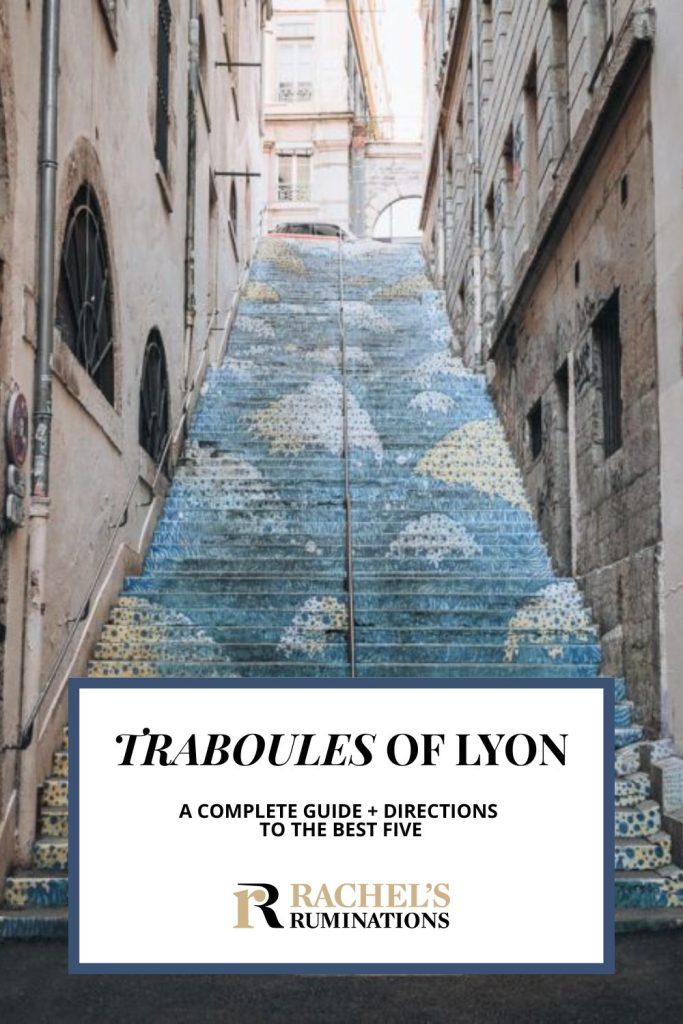
The traboules are spread throughout Lyon, often masked as residential buildings or businesses. So, if you want to visit them, you’ll need some treasure hunting skills and a good guide! In this post, we’ll explore what makes these traboules so special, where you can find them, and how to visit the best traboules in Lyon.
A brief history of Lyon’s traboules
The origins of Lyon’s traboules can be traced back to the 4th century. During this time, the city had two distinct sections. One was on a steep hill, and this was the upper district. The second, or lower district, sat on the banks of the river Saône. Since the Saône River was the only source of fresh water, residents needed a way to quickly access the river. This is when the first traboules appeared.
Later, in the mid-19th century, the silk trade started booming in Lyon’s Croix Rousse district. The silk workers (or Canuts) needed a way to transport their products, so they used the traboules.
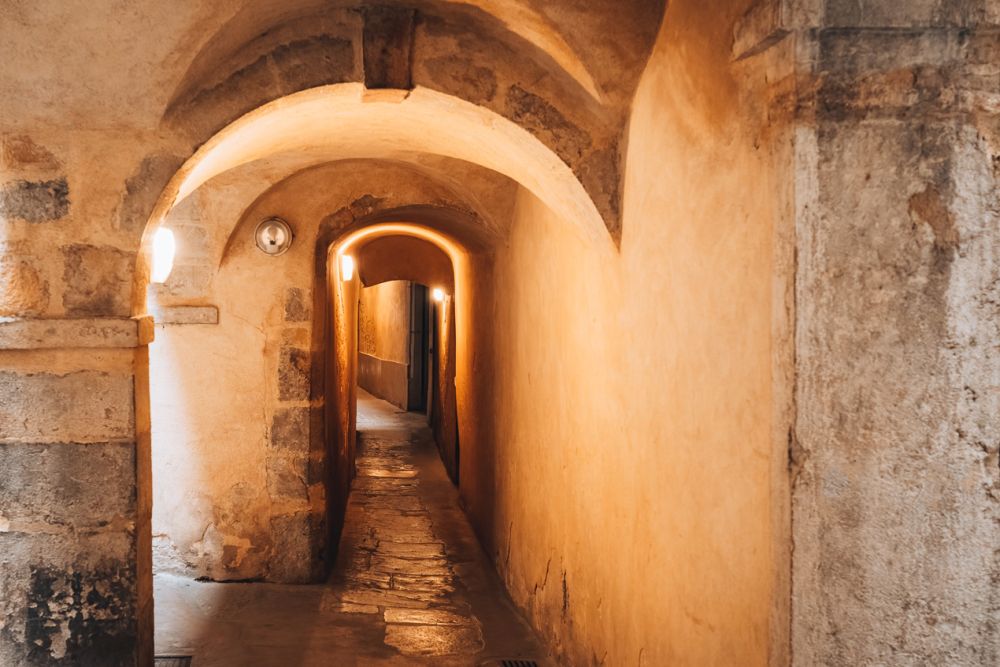
As the industry became more prosperous, the number of silk workers grew exponentially. There were over 10,000 weavers at one point. At this transitional moment in the Industrial Revolution, the Canuts worked in the pre-industrial way, essentially doing piecework, while the large silk manufacturers finished the production process in factories and wealthy silk traders (often the same people) sold the finished products.
Unfortunately, the Canuts’ working conditions did not reflect the success their products were seeing when they sold their work on to these wealthy silk merchants. This fueled a series of uprisings called the Canut Revolts in 1831, 1834 and 1848. During these revolts, the Canuts used the traboules as places of refuge.
But the role of the traboules in Lyon’s history didn’t stop there. In fact, during World War II, these traboules served their greatest purpose. While the German army was slowly taking over France, the citizens of Lyon had a different plan. They knew they could use these hidden passageways to hide from German forces. And that’s exactly what they did.
They moved through the city undetected, installed secret networks, and created resistance groups. All of which wouldn’t have been possible without the traboules. It’s said these passageways actually prevented Germany from taking total control of the city in the Second World War.
This history makes the traboules central to Lyon’s history: as remaining evidence of a growing city in the Middle Ages, and as landmarks of both the Canut revolts and, later, the wartime resistance.
You might also like to read these articles:
5 must-see traboules in Lyon
At one point there were hundreds of traboules in Lyon. Many former secret passageways are woven into the heart of the city of Lyon, which today is the listed UNESCO World Heritage site “Historic Site of Lyon.” Elements of former traboules have been incorporated into homes and apartment buildings as private courtyards and are now private property. Today, only 40 publicly accessible traboules remain, and it would take a long time to see them all.
So, which ones should you see? Below is a list of the best traboules in Lyon to visit.
1. Traboule de la Cour des Voraces
Located in the Croix-Rousse neighborhood, the Traboule de la Cour des Voraces is the most famous traboule in Lyon. It’s where many of the silk workers hid during the revolts. And, today, it stands as a symbol of resistance. It’s even classified as a historical monument.
In general, this is a rather complicated traboule. It winds through a series of apartment buildings connecting three streets. At the center, you’ll find the oldest reinforced staircase in the city. While it’s not the most beautiful, the history behind it is absolutely fascinating. It will no doubt be the perfect addition to your Lyon itinerary.
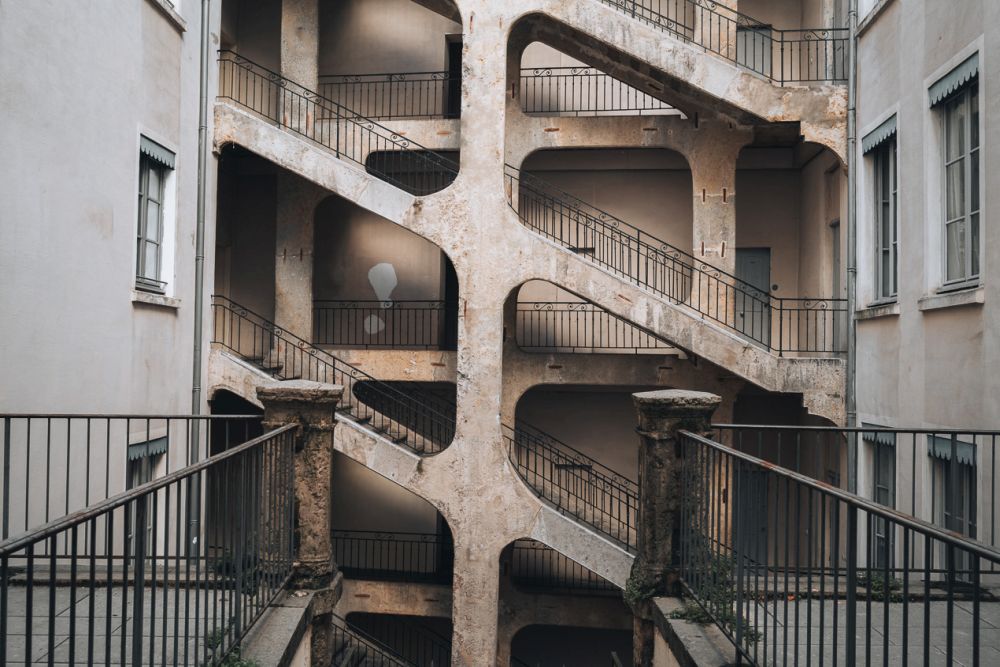
Entrances:
- 9 Place Colbert – This entrance gives direct access to the staircase.
- 14 Montée Saint-Sébastien – This is the easiest entrance to find. There’s a massive sign ‘La Cour des Voraces’.
- 29 Rue Imbert Colomès
Nearest metro station: Croix Paquet (Line C)
2. The longest traboule in Lyon
In the center of Vieux Lyon (Old Lyon), between two of the most picturesque streets, lies the longest traboule in the city. And, of the passageways, it’s one of the most difficult to find. You’ll most likely pass right by it without realizing.
When you arrive at one of the entrances, you’ll think it’s someone’s apartment, but it’s not. Just push through the door. Once you do, you’ll enter a small, low-hanging arched walkway that opens to a hidden courtyard. It takes about five minutes to walk through its narrow passageways, so if you want to spend more time, stop by the Ô Passage at 27 Rue du Boeuf. This little Salon De Thé has tables in the back that look out into the traboule!
Entrances: 54 Rue Saint-Jean and 27 Rue du Boeuf
Nearest metro station: Vieux Lyon – Cathédrale Saint-Jean (Line D)
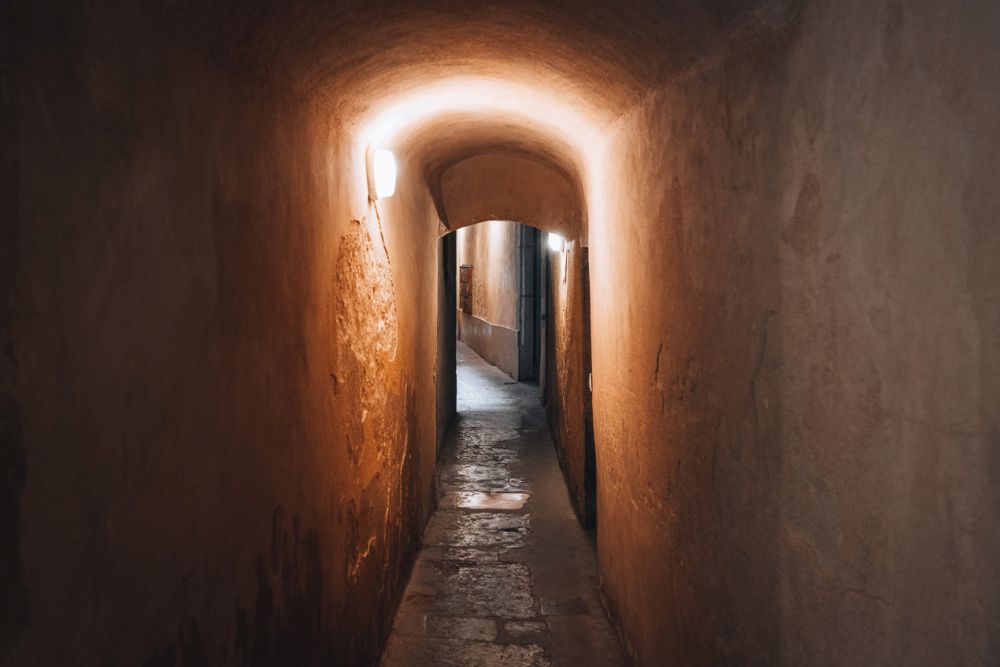
3. Passage Mermet
This passage connects the upper section of La Croix Rousse to the lower part. In the middle is a beautifully-painted staircase called Escalier Mermet. It’s also one of the few traboules that isn’t covered. The staircase is very steep and it’s not for anyone who hates stairs. So, if you’re only interested in visiting the steps and the painting, head to the entrance on Rue René Leynaud.
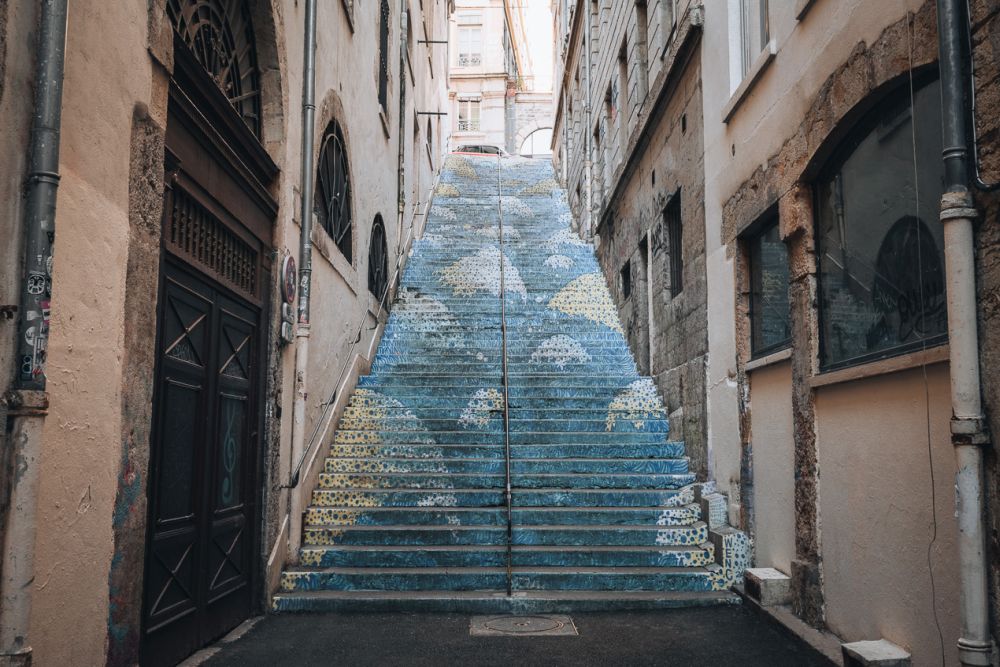
Entrances: 25 Rue René Leynaud and 25 Rue Burdeau
Nearest metro station: Hôtel de Ville L. Pradel (Lines A and C)
4. Place des Terreaux
Place des Terreaux is a historic square at the foot of the Croix Rousse district on the Presqu’Île. Here you’ll find Lyon’s City Hall, the Museum of Fine Arts of Lyon, and the magnificent Bartholdi Fountain. It’s also the start of a series of traboules that lead to the Traboule de la Cour des Voraces. So you can spend the morning visiting the area before starting your adventure.
Useful tip: While there is a traboule located in the square at 6 Place des Terreaux, it’s currently closed. So, you’ll need to go to the corner of Place des Terreaux and Sainte-Marie-des-Terreaux for the first traboule. There are directions on the buildings to help you find your way.

Nearest metro station: Hôtel de Ville L. Pradel (Lines A and C)
5. La Tour Rose
Tucked away in one of the courtyards of Vieux Lyon is La Tour Rose. This 16th century tower is known for its unique orange-pink color and Renaissance style architecture. For many years, the building was home to a luxury hotel and a Michelin-starred restaurant. It has since changed ownership and the courtyard around the tower has been redone.
The stairwell that houses the traboule is closed to tourists, but the Food Traboule restaurant offers an excellent view.
Address: 22 Rue du Bœuf
Nearest metro station: Vieux Lyon – Cathédrale Saint-Jean (Line D)
Book your accommodations in Lyon here.
How to find traboules in Lyon
There’s no denying that the traboules in Lyon are difficult to find. It’s not uncommon to see visitors circling up and down streets trying to locate an entrance. So, to help you on your adventure here are a few tips on how to find the traboules in Lyon.
Map of the Lyon traboules
All of the traboule entrances mentioned above are marked on the map below:
How to find traboules in La Croix-Rousse
The traboules in the Croix-Rousse district of Lyon are much easier to find than the ones in the Old Town. There’s actually a traboule circuit that you can follow. From start to finish it takes about two hours.
Every entrance is labeled with a symbol that is clearly visible. And as you move through the traboules, there are arrows indicating where you need to go next. They are impossible to miss.
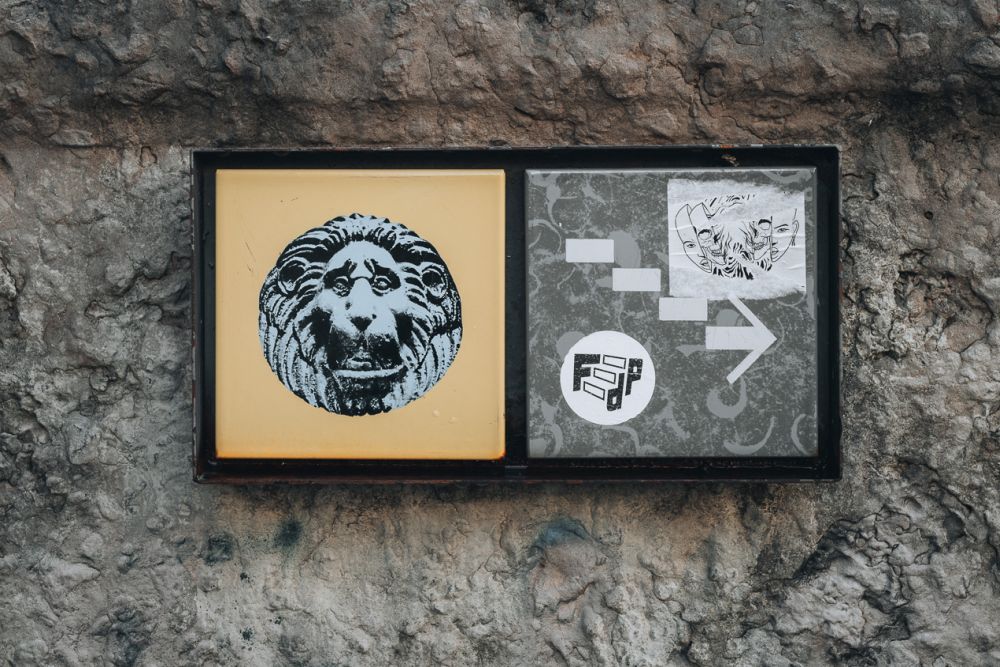
Useful tip: In some cases, you’ll see two arrows pointing in different directions. As an example, there are several spots where one arrow points down a staircase and another says to go straight. This means there are several traboules in that area. They eventually lead to the same place. So, you can follow both or pick only one.
How to find traboules in Vieux Lyon
The traboules in Vieux Lyon are not easy to spot. Most of the time there is a washed-out bronze sign on the door, but not always. And, even if there is a sign, chances are you won’t notice it. So, for the alleyways in this part of the city, it’s best to note the addresses ahead of time. Then, when you come in front of the entrance, just push the door open.
To visit one traboule in Vieux Lyon won’t take you more than five or ten minutes. But if you want to see them all, it will take a couple of hours.
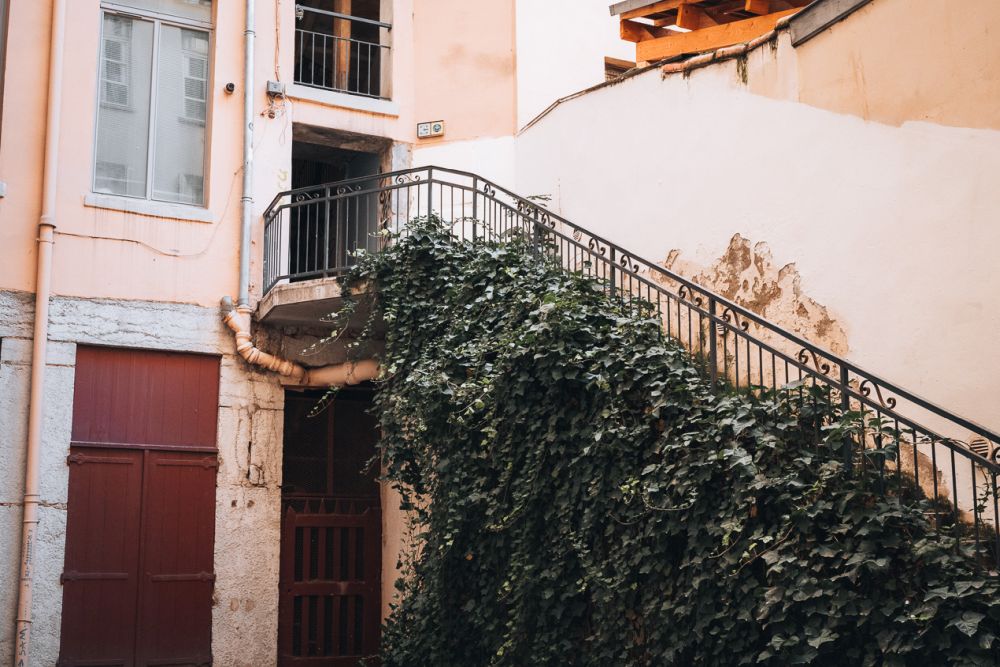
Tips for visiting Lyon’s secret alleyways
Most of the traboules pass through private alleyways and courtyards. As you can imagine, many residents don’t want to leave their front doors unlocked. So, in 1990, Lyon created the Courtyard and Traboule Agreement. It states that the city will pay for maintaining the passageways if the owners keep the entrances open to the public.
Opening hours: The traboules are open every day from 7:00 am to 7:00 pm. Sometimes, however, residents will close and lock the doors if tourists are too loud. Keep this in mind as you visit the traboules and remember to be respectful.
You can visit the traboules on your own or with a guided tour. A self-guided tour will take longer because you’ll have to find all the entrances on your own. But it’s like a fun little treasure hunt! If you plan on doing the entire traboule circuit in La Croix Rousse and seeing a few passageways in Vieux Lyon, put aside three to four hours.
Several guided tours are available in Lyon. In general, most tours take about two hours, but only visit one district (either Vieux Lyon or La Croix Rousse). This is a good option if you’re short on time or if you don’t want to search for the entrances.
- This guided walking tour of Lyon includes some Vieux Lyon traboules.
- This self-guided audio tour of La Croix Rousse includes some traboules.
Visiting the traboules requires a lot of walking. Wear a good pair of comfortable walking shoes and take along a bottle of water and a snack.
Accessibility: Lyon’s traboules are open to everyone and it’s a very family-friendly activity. However, they are not wheelchair accessible.
Several alleyways have narrow steep stairs with limited lighting. If you enter a traboule and it’s dark, you should proceed with caution. There may be a step down that’s not obvious.
Lyon’s traboules are a fascinating window into the city’s past and present. Whether you choose to explore them on your own or take a guided tour, these hidden pathways are one of the most unique ways to visit Lyon. You’ll learn about its history and culture while working on your sleuthing skills! It’s a perfect activity for all ages and for anyone looking to explore something truly special in France. So if you ever find yourself in Lyon, make sure not to miss out on this incredible adventure!
My travel recommendations
Planning travel
- Skyscanner is where I always start my flight searches.
- Booking.com is the company I use most for finding accommodations. If you prefer, Expedia offers more or less the same.
- Discover Cars offers an easy way to compare prices from all of the major car-rental companies in one place.
- Use Viator or GetYourGuide to find walking tours, day tours, airport pickups, city cards, tickets and whatever else you need at your destination.
- Bookmundi is great when you’re looking for a longer tour of a few days to a few weeks, private or with a group, pretty much anywhere in the world. Lots of different tour companies list their tours here, so you can comparison shop.
- GetTransfer is the place to book your airport-to-hotel transfers (and vice-versa). It’s so reassuring to have this all set up and paid for ahead of time, rather than having to make decisions after a long, tiring flight!
- Buy a GoCity Pass when you’re planning to do a lot of sightseeing on a city trip. It can save you a lot on admissions to museums and other attractions in big cities like New York and Amsterdam.
- Ferryhopper is a convenient way to book ferries ahead of time. They cover ferry bookings in 33 different countries at last count.
Other travel-related items
- It’s really awkward to have to rely on WIFI when you travel overseas. I’ve tried several e-sim cards, and GigSky’s e-sim was the one that was easiest to activate and use. You buy it through their app and activate it when you need it. Use the code RACHEL10 to get a 10% discount!
- Another option I just recently tried for the first time is a portable wifi modem by WifiCandy. It supports up to 8 devices and you just carry it along in your pocket or bag! If you’re traveling with a family or group, it might end up cheaper to use than an e-sim. Use the code RACHELSRUMINATIONS for a 10% discount.
- I’m a fan of SCOTTeVEST’s jackets and vests because when I wear one, I don’t have to carry a handbag. I feel like all my stuff is safer when I travel because it’s in inside pockets close to my body.
- I use ExpressVPN on my phone and laptop when I travel. It keeps me safe from hackers when I use public or hotel wifi.




